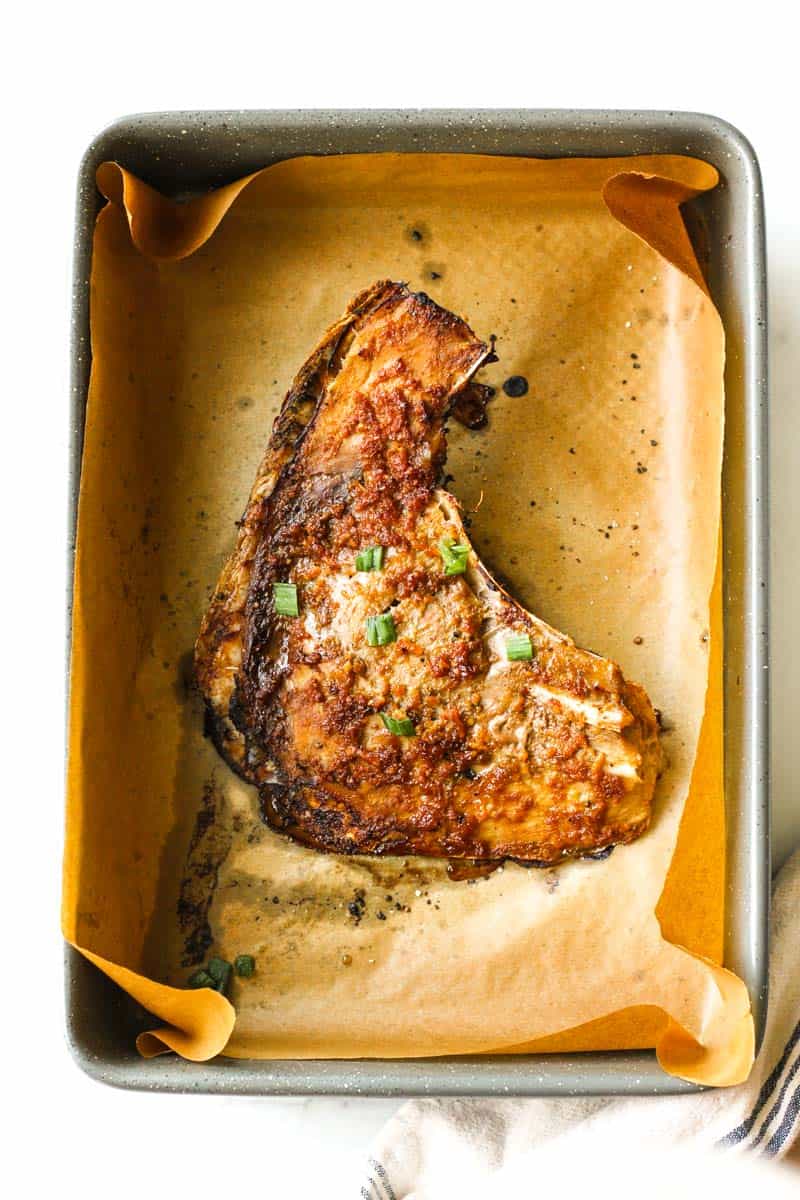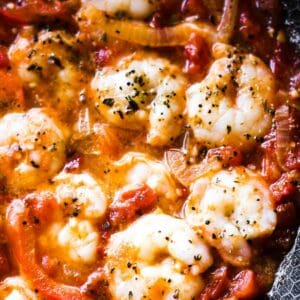This tuna collar recipe is easy and simple to prepare any night of the week! A whole tuna collar is oven-baked with a sweet and sticky soy ginger glaze. It's a restaurant-quality seafood meal served with green onions or toasted sesame seeds.
Also try my Parmesan crusted walleye, baked pollock, salmon collar recipe and broiled salmon with skin recipes.

Fish collars are one of the most overlooked parts of the fish, but it's actually a very delicious delicacy! The meat right between the head and body behind the gills is called the fish collar. It's a bony piece of meat covered in thick tuna skin so it's hard to overcook and the meat won't easily dry out.
The meat itself is very tender and juicy with a rich fish flavor that isn't fishy tasting at all.
Tuna collars are amazing baked in the oven and this sweet and savory soy ginger glaze makes this tuna collar recipe even better!
Serve your baked fish collar with steamed rice or noodles and then you'll have a wonderful 30-minute meal that tastes like it came from your favorite Japanese sushi restaurant!
Tuna collar recipe instructions
Soy Ginger Glaze Preparation
Start by preparing all the ingredients for the glaze. Measure out the soy sauce, mirin, honey (or brown sugar), and sesame oil. Peel and finely mince the ginger and garlic.
In a small saucepan, pour in the soy sauce, mirin, honey (or brown sugar), minced ginger, and minced garlic. Place the saucepan on the stove over medium heat. Once the mixture starts to bubble, lower the heat to maintain a gentle simmer.

Allow the mixture to simmer, stirring occasionally, for about 5 minutes or until it becomes slightly syrupy. After removing the saucepan from the heat, gently stir in the sesame oil. Set the glaze aside to cool down to room temperature.
Baking the Tuna Collar
Turn on your oven and set it to 375°F, letting it heat up while you prepare the tuna collar. Take the tuna collar and lay it out on a clean working surface. Use a brush or your fingers to lightly coat the collar with olive oil or sesame oil.
Evenly sprinkle salt and pepper on both sides of the collar, ensuring it's well-seasoned. Position the seasoned tuna collar in a roasting pan or on a baking sheet that has been covered with aluminum foil. This helps with easier cleanup. Transfer the prepared baking sheet or roasting pan into the preheated oven. Bake the tuna collar for about 10-12 minutes.
After the initial baking time, remove the pan from the oven (be careful as it will be hot). Using a brush or spoon, generously baste the collar with the soy ginger glaze you prepared earlier.
Return the collar to the oven and bake for an additional 10-13 minutes. The tuna should be moist inside and flake easily when tested with a fork. Once the tuna collar is fully cooked, carefully remove it from the oven.

Let it sit for a few minutes to allow the juices to redistribute. For presentation, drizzle any remaining glaze over the collar. If you're using garnishes, sprinkle sliced green onions and toasted sesame seeds on top.
Remember, the exact cooking time might vary depending on the thickness of the tuna collar and your specific oven. Monitor the collar to avoid overcooking and adjust baking times if necessary. Enjoy your delicately glazed and baked tuna collar, a treat that's sure to impress your guests!
Recipe ingredients
Tuna collar. I used a yellowfin tuna collar. Make sure that it is cleaned, and if using frozen, that is fully defrosted before cooking.
Oil. Brush your tuna collar with either olive oil or sesame oil before baking to keep it moist and juicy while it cooks.
Soy sauce. The main ingredient in my homemade soy ginger glaze. It gives a rich umami and savory flavor to the fish.
Mirin. This fermented rice cooking wine is sweet and slightly tangy. It's a staple in Japanese cuisine.
Honey. To further sweeten and thicken the glaze as it cooks.
Ginger and garlic. Grated ginger adds a fresh zesty punch to this recipe and serves as a nice contrast to the other savory and salty flavors used.
Sesame oil. Adds a subtle toasty and nutty taste to the glaze.
Optional. You can decide to serve your tuna collar topped with freshly sliced green onions or with toasted sesame seeds for a nutty crunch.
Would you like to save this?

Substitutions
Yellowfin tuna collar. Yellowtail, blackfin, or skipjack tuna collars are also great choices!
Mirin. Try using dry sherry or sweet marsala wine. Dry white wine or rice vinegar can also be used. Since these two ingredients are a little sour tasting, make sure to add an extra teaspoon of brown sugar or honey to help balance out the flavors.
Soy sauce. Use tamari or liquid aminos. Both are a little less salty than regular soy sauce and tamari has a slightly sweeter taste to it.
Honey. Use brown sugar to give a similar flavor to the glaze.
Garlic. Use jarred minced garlic or ½ teaspoon of garlic powder if you are in a pinch. Just keep in mind that the flavor won't be as strong.
Expert tips
Marinating: If time allows, consider marinating the tuna collar in a bit of the glaze for about 30 minutes before cooking. This will infuse the meat with more flavor.
Basting: Continuously basting the tuna collar with the soy ginger glaze as it cooks will not only add flavor but also give the fish a lovely glaze and prevent it from drying out.
Temperature Check: Use a meat thermometer to check the internal temperature of the thickest part of the tuna collar. It should read about 125°F to 130°F for medium-rare.
Broiler Option: If you want a slightly charred exterior, place the tuna collar under a broiler for the last 2-3 minutes of cooking.
Storage suggestions
Store the cooked tuna collar in an airtight container in the refrigerator for up to 2 days. When you're ready to reheat, place it in a preheated oven at 325°F until warmed through, about 10 minutes, to retain its moisture and flavor. Or microwave for a minute (this method is quicker but can dry out the fish).

Side dishes
Honestly, when i made this tuna collar recipe i just enjoyed it my itself, no side dishes needed! I was very hungry and the collar was just delicious. But if you prefer to have it with a side, here are some of my favorite sides:
Steamed Jasmine Rice: The simplicity of steamed rice will balance the robust flavors of the tuna collar.
Sautéed Vegetables: Think of colorful bell peppers, snap peas, or baby bok choy sautéed with a touch of garlic and soy sauce.
Miso Soup: A light and flavorful miso soup with tofu and seaweed will complement the umami flavors of the tuna collar.
Pickled Vegetables: A side of pickled radishes, cucumbers, or carrots will offer a tangy contrast to the savory fish.
Edamame: Steamed edamame beans sprinkled with a pinch of sea salt make for a healthy and delightful side.
Kimchi: The spicy and fermented flavors of kimchi provide a delightful contrast and can cut through the rich, oily nature of the fish.
Frequently asked questions
The collar of a fish is the meat between the gills and body of the fish. This is basically the clavicle or collarbone section of a fish, hence the name. It contains very fatty and tender meat.
The fish collar is one of the most tender, juicy, and fatty parts of the fish. Even if you are cooking a lean fish like tuna, the fish collar is a delicate treat and it's always moist and flavorful.
Yes, fish skin is completely edible. It is sometimes avoided because depending on the type of fish you are using, it's possible that it contains high levels of mercury or other contaminants that you might want to avoid.
Fish collars are often thrown away with the fish head, so definitely ask your local fishmonger if they can reserve it for you. Also, look for them on online seafood delivery websites or check out your local seafood or farmer's markets as well!

You may also like
- Grouper ceviche
- Air fryer frozen tuna steaks
- Thresher shark recipe
- Conch salad
- Salmon head soup
- Bang bang salmon bites
Hope you will like this broiled tuna collar recipe as much as we did. Please rate the recipe if you made it and leave a comment below if you have any questions or suggestions.

Tuna Collar Recipe (with Soy Ginger Glaze)
This tuna collar recipe is easy and simple to prepare any night of the week! A whole tuna collar is oven-baked with a sweet and sticky soy ginger glaze. It's a restaurant-quality seafood meal served with green onions or toasted sesame seeds.
Ingredients
- 1 tuna collar, cleaned
- Salt and pepper, to taste
- Olive oil or sesame oil, for brushing
- ⅓ cup soy sauce
- 2 tablespoons mirin (Japanese rice wine)
- 2 tablespoons honey or brown sugar
- 1 tablespoon finely grated fresh ginger
- 2 garlic cloves, minced
- 1 teaspoon sesame oil
Instructions
- In a small saucepan, combine soy sauce, mirin, honey or brown sugar, ginger, and garlic. Bring to a simmer over medium heat. Reduce the heat and let it simmer until it slightly thickens, about 5 minutes. Remove from heat and stir in the sesame oil. Let it cool.
- Preheat your oven to 375°F. Lightly brush the tuna collar with olive or sesame oil and season with salt and pepper.
- Place the tuna collar in a roasting pan or on a baking sheet lined with aluminum foil. Bake in the preheated oven for about 20-25 minutes, basting with the soy ginger glaze halfway through. The meat should be moist and easily flake when it's done.
- Once cooked through, remove from the oven and let it rest for a few minutes. Drizzle with any remaining glaze, garnish with sliced green onions and toasted sesame seeds, if using, and serve.
- Note: Cooking times can vary depending on the thickness of the tuna collar and your specific oven, so keep an eye on it. Adjust the times as needed.
Notes
Nutrition information is automatically calculated, so should only be used as an approximation.
Marinating: If time allows, consider marinating the tuna collar in a bit of the glaze for about 30 minutes before cooking. This will infuse the meat with more flavor.
Basting: Continuously basting the tuna collar with the soy ginger glaze as it cooks will not only add flavor but also give the fish a lovely glaze and prevent it from drying out.
Temperature Check: Use a meat thermometer to check the internal temperature of the thickest part of the tuna collar. It should read about 125°F to 130°F for medium-rare.
Broiler Option: If you want a slightly charred exterior, place the tuna collar under a broiler for the last 2-3 minutes of cooking.
Nutrition Information:
Yield: 1 Serving Size: 1Amount Per Serving: Calories: 716Total Fat: 37gSaturated Fat: 5gTrans Fat: 0gUnsaturated Fat: 30gCholesterol: 40mgSodium: 4975mgCarbohydrates: 63gFiber: 3gSugar: 52gProtein: 34g





Kathy
Directions were good, I did have to look up how to clean the collar. The glaze on the fish was delicious.